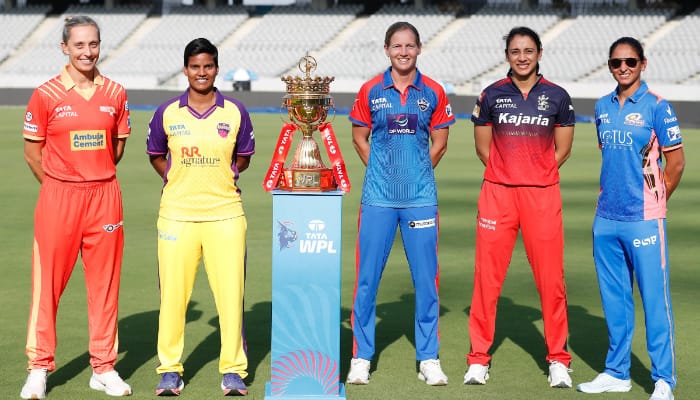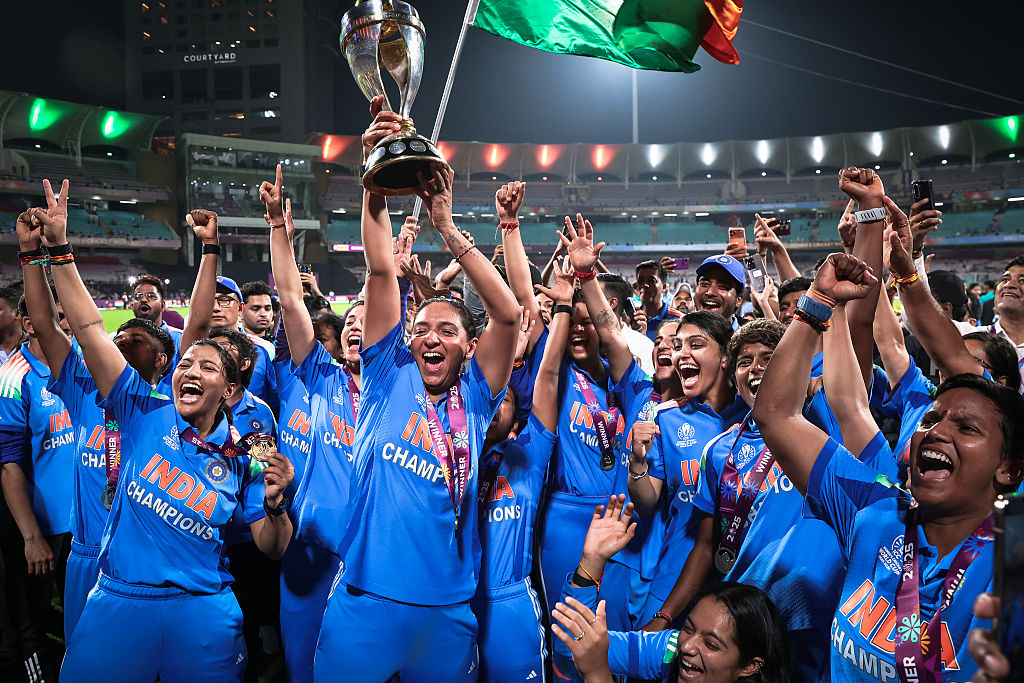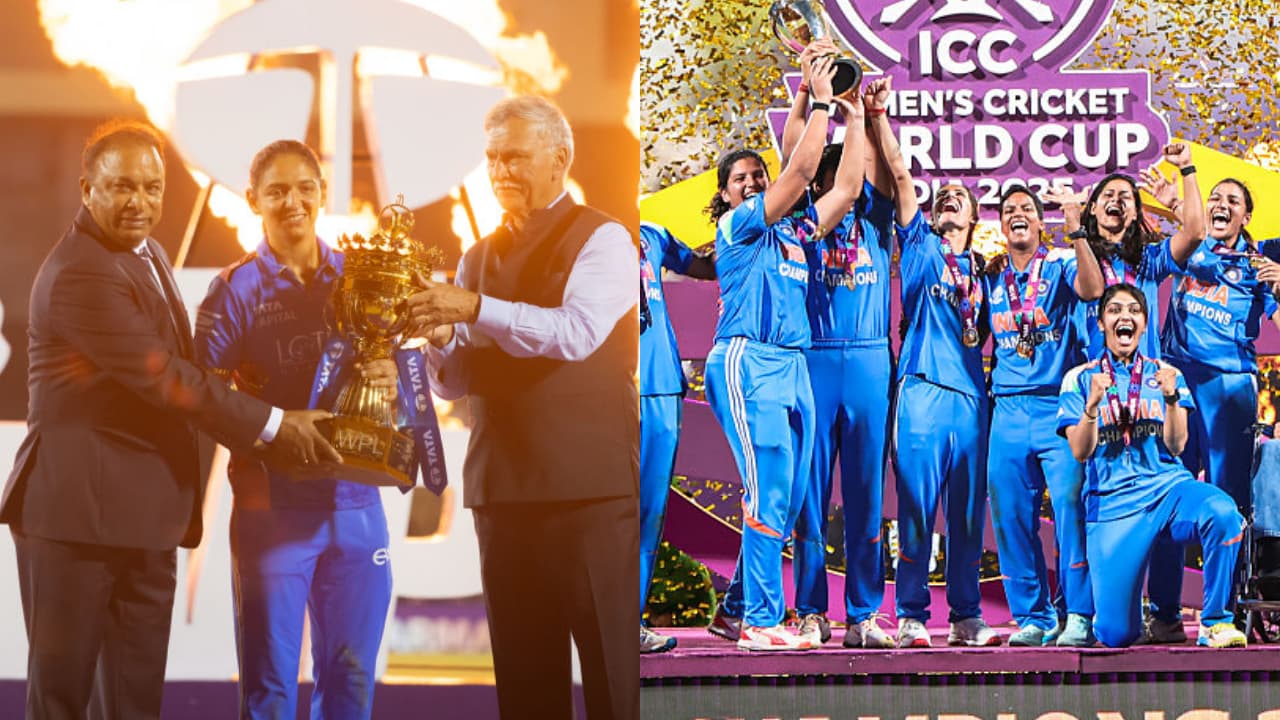Team India’s historic Women’s World Cup win is credited to the WPL, which honed skills, offered international exposure, and discovered new talent, building a stronger, competitive squad that clinched the coveted trophy after 47 years.
Team India’s long-awaited dream of clinching the coveted Women’s World Cup trophy finally came true when the Harmanpreet Kaur-led side defeated South Africa in a thrilling final at the DY Patil Sports Academy Stadium in Guwahati on Sunday, November 2. The Women in Blue took 47 years to finally lift the prestigious ICC Women’s World Cup trophy since their first participation in 1978, marking a historic moment in Indian women’s cricket.
As Team India lifted the coveted trophy in front of the home crowd, the Women’s Premier League was brought into discussion as a key catalyst for their success, with fans and experts crediting the league for refining skills, boosting competition exposure, especially playing alongside international stars, and deepening the talent pool ahead of the Women’s World Cup 2025.
The WPL witnessed the participation of international players, which provided Indian players with high-quality competition and helped them adapt to diverse playing styles, which strengthened the Indian squad for the Women’s World Cup 2025.
Women’s T20 Challenge to WPL
After India finished as runners-up in the 2017 Women’s World Cup, there was a paradigm shift in the way the Indian women’s cricket was structured and promoted, leading to the creation of the Women’s T20 Challenge, which later evolved into the full-fledged Women’s Premier League (WPL), providing a professional platform for talent development.
The Board of Control for Cricket in India (BCCI)’s decision to launch the WPL was a major turning point, giving Indian women cricketers a consistent exposure to high-quality competition, a professional training environment, and the opportunity to play alongside or against international talent. The WPL provided a platform to domestic and grassroots players, which helped them uncover new talent, build confidence, and prepare a deeper and more competitive squad capable of performing on the world stage.
Scroll to load tweet…
Given the lucrative contracts and money that go into the WPL, the league has become an attractive platform, motivating players to perform consistently, improve their skills, and aim for national recognition as well as selection.
In the last three seasons of the Women’s Premier League, the tournament has featured packed stadiums, thrilling matches, and rising talent, highlighting the perception that a new powerhouse in women’s cricket was being forged in India.
WPL: Driving Economic Growth and Social Impact
The growth and interest in Indian women’s cricket were evident after the 2017 Women’s World Cup, and the launch of the Women’s Premier League further accelerated this momentum by gaining significant economic opportunities, increasing sponsorships, creating jobs, and inspiring a new generation of girls to take up cricket professionally.
According to the research paper ‘The Women’s Premier League -A Paradigm Shift in Indian ‘Women’s Cricket’, the league’s growing brand appeal has helped it attract mainstream sponsorships, signalling that women’s cricket in India has become a commercially viable and influential force. The brands leveraged the WPL’s growing reach and fresh audience segments, giving them public attention and a rare opportunity to support women’s sports in India.
The support for women’s cricket in India was evident from the fact that five WPL teams, Mumbai, Bengaluru, Ahmedabad, Lucknow, and Delhi, collectively sold for INR 4,670 crore, which is an average of around INR 934 crore per franchise, highlighting the enormous commercial value and investor confidence in the Women’s Premier League.

Talking about social impact, the Women’s Premier League has changed the perception of how women’s cricket in India is viewed. The popularity of the league has further encouraged women to follow their aspirations in the sports industry by challenging the conventional gender norms that have traditionally limited opportunities and recognition for female athletes.
According to the research paper, the WPL is expected to accomplish the bigger task of gaining a larger audience for different mobile apps, and the advertiser interest has been quite high following the growth of women’s cricket in India. The 951-crore deal for media rights over five years itself underscores the league’s commercial potential, signaling strong confidence from the broadcasters and advertisers in the growing market for women’s sports content.
BCCI Bridging the Gaps in Women’s Cricket
Women’s cricket in India had faced certain challenges, including a lack of proper infrastructure and facilities, gender bias, a lack of media exposure, and sponsorships. This also changed with the growth of the sport for women in India following the 2017 Women’s World Cup and the launch of the Women’s Premier League.
According to the research paper, there is a format department in women’s cricket, enabling the BCCI to allocate and invest resources for better infrastructure and facilities in women’s cricket in India. To bridge the gap of gender inequality, the BCCI has launched various domestic tournaments, initiatives, and campaigns to provide equal opportunities, enhance visibility, and support the professional development of women cricketers in India.
The lack of media coverage was one of the major challenges faced by women’s cricket in India, as the broadcasters focused on men’s cricket. According to the research paper, the BCCI has attempted to mitigate the gap between men’s and women’s cricket coverage in India by creating and beginning television presentations for women’s matches. This move by the board changed the perception of women’s cricket in India.
Last but not least, women’s cricket in India did not have sponsorships compared to men’s cricket, and therefore, female cricketers were unable to get lucrative deals. In order to ensure that women’s cricket in India gets adequate commercial support, the BCCI took certain steps to enhance the sponsorships, which allowed teams that participated in the Women’s T20 Challenge to connect to the brands that support women’s cricket.
WPL Paved the Way for India’s World Cup Glory
The Women’s Premier League has played a significant role in paving the way for Team India to clinch the Women’s World Cup triumph. The likes of Smriti Mandhana, Harmanpreet Kaur, Jemimah Rodrigues, Deepti Sharma, Richa Ghosh, and Shefali Verma were already known faces in Indian women’s cricket before the WPL, but it was the emergence of talents like Amanjot Kaur, Kranti Gaud, and Shree Charani, whose standout WPL performances earned them national call‑ups and added new firepower to India’s World Cup‑winning squad.
Shree Charani was the second-highest wicket-taker for India with 14 wickets in nine matches, while Kranti Gaud was the winning team’s best pacer with 9 wickets in 8 matches. Amanjot Kaur picked six wickets and scored 146 runs in seven matches, alongside her game-changing catch of South Africa skipper Laura Wolvaardt in the final.

The emergence of young talents through the Women’s Premier League not only strengthened India’s bench strength but also created a competitive environment that pushed established players to elevate their performance, ultimately contributing to the team’s historic World Cup victory.
India’s success at the Women’s World Cup triumph can largely be attributed to the synergy between talented players and experienced stars honed in the WPL, showcasing how a strong domestic league can transform a national team into a world-class side.
